The Garden District is one of the most beautiful areas in New Orleans. Visitors to this residential district come here to admire the elegant nineteenth-century houses, built in a variety of architectural styles.
The Garden District
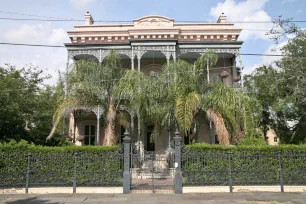
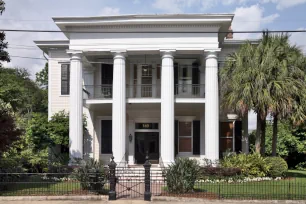
Shortly after Louisiana was purchased by the United States, protestant Americans started to settle in New Orleans. Many of them built houses upriver from the French Quarter at the site of a former plantation in the city of Lafayette, which was incorporated into New Orleans in 1852. In particular during the 1850s, when the city was booming, many wealthy merchants built beautiful mansions in architectural styles ranging from Neoclassical over Italianate to Beaux-Arts.
Despite this variety, the architecture is surprisingly coherent, partly thanks to the plantation style balconies and cast-iron fences that many of these buildings have in common. True to its name, the houses in the Garden district have luscious gardens planted with flowers, brushes and even palm trees. The streets are lined with stately oak trees.
The Houses
The Garden District is bounded by St. Charles Avenue, Jackson Avenue, Magazine Street and Louisiana Avenue. It can be reached by the St. Charles Streetcar and is best visited on foot. The Garden District is a quiet residential neighborhood, quite the opposite of the lively French Quarter, so you can peacefully admire the architecture and the gardens.
The most interesting houses can be found in the area around Second, Prytania and Coliseum streets. Below, an overview of some of the district’s most interesting houses.
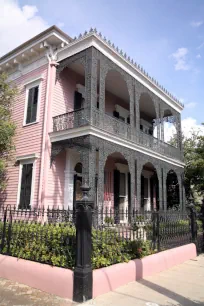
Musson House
One of the most photographed buildings in the Garden District is the Musson House, a lovely pink structure with magnificent cast-iron balconies situated at the corner of Coliseum and Third Street. It was built in 1850 for Michel Musson, uncle of artist Edgar Degas.
Robinson House
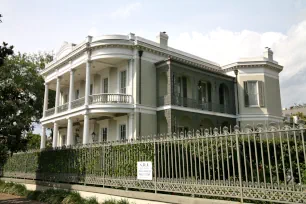
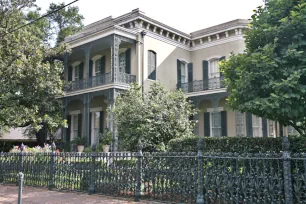
Opposite the Musson House, at 1415 Third Street, stands one of the Garden District’s most palatial mansions, the Robinson House. The Italianate mansion was built in 1860 by reputed local architects Henry Howard and James Gallier Jr.
Colonel Short’s Villa
Henry Howard was also responsible for the design of the grand mansion known as Colonel Short’s Villa, located at the corner of Prytania and Fourth Street. The house, with its beautiful cast-iron railings, was built in 1859 for Colonel Robert Short. The garden is enclosed by a cast-iron cornstalk fence.
Briggs-Staub House
The only Neo-Gothic building in the Garden District can be found at 2605 Prytania Street. It was designed by James Gallier Sr, best known for his Gallier Hall at Lafayette Square. The Briggs-Staub House, with its pointed arch windows, was built in 1849 for Cuthbert Bullitt. He refused to pay for it, and the house was sold to Charles Briggs, an English insurance broker.
Women’s Guild Opera House
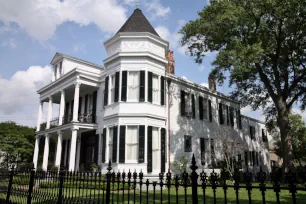
Previously known as the Davis-Seebold Residence, this Greek Revival with its small octagonal tower was built in 1865 at the corner of Prytania and Second Street. In 1966, it became the home of the Women’s Guild of the New Orleans Opera association.
Toby’s Corner
The oldest building in the Garden District is Toby’s Corner, a Greek Revival house at Prytania and First Street. It was built in 1838 for Thomas Toby, after whom the house is still named.
Louise McGehee School
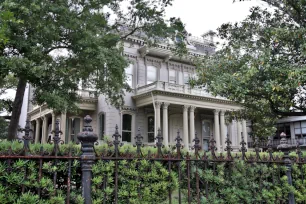
Opposite Toby’s Corner is the McGehee School building, a grand mansion designed in a mixture of the new Beaux-Arts style and the Neoclassical style. It was built in 1872 – after the civil war – for Bradish Johnson. The house is one of the most opulent in the district and was one of the first houses with an elevator. In 1929, it became home to a private school.
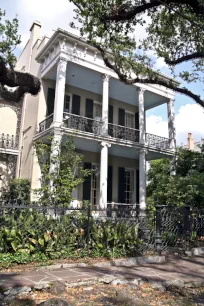
Rosegate
Rosegate, an 1856 Neoclassical house at 1239 First Street, is best known as the former residence of local writer Anne Rice, who lived here between 1991 and 2004. The house makes an appearance in the novel ‘Blood Cantide’.
Carroll-Crawford House
One of the most delightful houses in the Garden District is the Carroll-Crawford House, at 1315 First Street. The Italianate building with beautiful cast-iron balconies was built in 1869 for Joseph Carroll, a cotton merchant.
- Next: Moon Walk
- More Sights & Attractions in New Orleans

